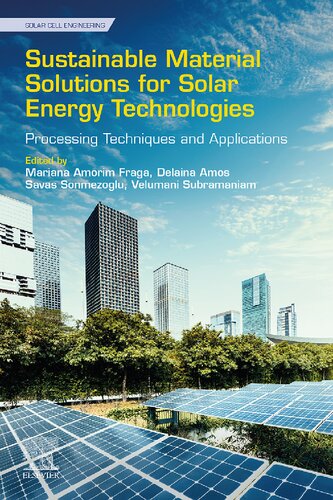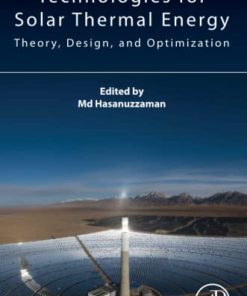Sustainable Material Solutions for Solar Energy Technologies Processing Techniques and Applications Solar Cell Engineering 1st Edition by Mariana Amorim Fraga ISBN 0128215933 9780128215937
$50.00 Original price was: $50.00.$25.00Current price is: $25.00.
Sustainable Material Solutions for Solar Energy Technologies Processing Techniques and Applications Solar Cell Engineering 1st Edition by Mariana Amorim Fraga – Ebook PDF Instant Download/Delivery: 0128215933, 9780128215937
Full dowload Sustainable Material Solutions for Solar Energy Technologies Processing Techniques and Applications Solar Cell Engineering 1st Edition after payment

Product details:
ISBN 10: 0128215933
ISBN 13: 9780128215937
Author: Mariana Amorim Fraga
Sustainable Material Solutions for Solar Energy Technologies: Processing Techniques and Applications provides an overview of challenges that must be addressed to efficiently utilize solar energy. The book explores novel materials and device architectures that have been developed to optimize energy conversion efficiencies and minimize environmental impacts. Advances in technologies for harnessing solar energy are extensively discussed, with topics including materials processing, device fabrication, sustainability of materials and manufacturing, and current state-of-the-art. Leading international experts discuss the applications, challenges, and future prospects of research in this increasingly vital field, providing a valuable resource for students and researchers working in this field.
- Explores the fundamentals of sustainable materials for solar energy applications, with in-depth discussions of the most promising material solutions for solar energy technologies: photocatalysis, photovoltaic, hydrogen production, harvesting and storage
- Discusses the environmental challenges to be overcome and importance of efficient materials utilization for clean energy
- Looks at design materials processing and optimization of device fabrication via metrics such as power-to-weight ratio, effectiveness at EOL compared to BOL, and life-cycle analysis
Sustainable Material Solutions for Solar Energy Technologies Processing Techniques and Applications Solar Cell Engineering 1st Table of contents:
Section I: Trends in Materials Development for Solar Energy Applications
Chapter 1. Bismuth-based nanomaterials for energy applications
Abstract
1.1 Introduction
1.2 Photovoltaics
1.3 Thermoelectric devices
1.4 Batteries & Supercapacitors
1.5 Solar-hydrogen production
1.6 Conclusions
Acknowledgements
References
Chapter 2. Emergent materials and concepts for solar cell applications
Abstract
2.1 Introduction
2.2 Perovskite solar cells
2.3 III–V semiconductor materials for multijunction solar cells applications
2.4 Final remarks and future perspectives
References
Chapter 3. Novel dielectrics compounds grown by atomic layer deposition as sustainable materials for chalcogenides thin-films photovoltaics technologies
Abstract
3.1 Introduction
3.2 Atomic layer deposition technique
3.3 Atomic layer deposition applied on chalcogenides thin films technologies
3.4 Final remarks
Acknowledgments
References
Chapter 4. First principles methods for solar energy harvesting materials
Abstract
4.1 Introduction
4.2 Fundamental concepts
4.3 Selected materials with solar energy harvesting implementations
4.4 Conclusion
References
Section II: Sustainable Materials for Photovoltaics
Chapter 5. Introduction to photovoltaics and alternative materials for silicon in photovoltaic energy conversion
Abstract
5.1 Introduction
5.2 Current status of photovoltaics
5.3 Fundamental properties of photovoltaics semiconductors
5.4 Physics of solar cell
5.5 Categories of the photovoltaic market
5.6 Commercialization of Si solar cells
5.7 Status of alternative photovoltaics materials
5.8 Thin film technology
5.9 Material selection in thin film technology
5.10 Thin film deposition techniques
5.11 Copper indium gallium selenide-based solar cell
5.12 Cadmium telluride solar cells
5.13 Multijunction solar cells
5.14 Emerging solar cell technologies
5.15 Summary, conclusions, and outlook
Acknowledgment
References
Chapter 6. An overview on ferroelectric photovoltaic materials
Abstract
6.1 Overview
6.2 Ferroelectric materials
6.3 Photovoltaic effect
6.4 Barium titanate
6.5 Bismuth ferrite
6.6 Conclusion
Acknowledgments
References
Chapter 7. Nanostructured materials for high efficiency solar cells
Abstract
7.1 Introduction
7.2 Nanostructures and quantum mechanics
7.3 Quantum wells in solar cells
7.4 Quantum wires (nanowires) in solar cells
7.5 Quantum dots in solar cells
7.6 Conclusions
Acknowledgments
References
Chapter 8. Crystalline-silicon heterojunction solar cells with graphene incorporation
Abstract
8.1 Heterojunction solar cells and graphene
8.2 Fabrication of silicon heterojunction solar cell
8.3 Synthesis of graphene
8.4 Conclusion
Acknowledgment
References
Chapter 9. Tin halide perovskites for efficient lead-free solar cells
Abstract
9.1 Introduction
9.2 Halide perovskite solar cells: why tin?
9.3 ASnX3: a brief historical excursus
9.4 Toward efficient and stable ASnX3 PSCs
9.5 Conclusion
References
Section III: Sustainable Materials for Photocatalysis and Water Splitting
Chapter 10. Photocatalysis using bismuth-based heterostructured nanomaterials for visible light harvesting
Abstract
10.1 Introduction
10.2 Fundamentals of heterogeneous photocatalysis
10.3 Bismuth-based heterostructures for photocatalytic applications
10.4 Conclusions
Acknowledgments
References
Chapter 11. Recent advances in 2D MXene-based heterostructured photocatalytic materials
Abstract
11.1 Introduction
11.2 Synthesis of 2D-MXenes
11.3 Photocatalytic applications
11.4 Conclusion and future prospects
Acknowledgments
References
Chapter 12. Atomic layer deposition of materials for solar water splitting
Abstract
12.1 Introduction
12.2 Solar energy
12.3 Photoelectrochemical cells
12.4 Hydrogen generation from water photoelectrolysis
12.5 Materials for photoelectrode
12.6 Atomic layer deposition technique: process and equipment
12.7 Final remarks
Acknowledgments
References
Section IV: Sustainable Materials for Thermal Energy Systems
Chapter 13. Solar selective coatings and materials for high-temperature solar thermal applications
Abstract
13.1 Introduction
13.2 CSP efficiency considerations: the concept of solar selectivity
13.3 State-of-the-art review of solar absorber surfaces and materials for high-temperature applications (> 565°C in air)
13.4 Current trends and issues
13.5 Roadmap for concentrated solar power absorbing surfaces and materials
Acknowledgments
References
Chapter 14. Applications of wastes based on inorganic salts as low-cost thermal energy storage materials
Abstract
14.1 Introduction
14.2 Thermal energy storage
14.3 Overview of industrial waste studied as thermal energy storage materials
14.4 Inorganic salt-based products and wastes as low-cost materials for sustainable thermal energy storage
14.5 Challenges for the application of waste and by-products in thermal energy storage systems
14.6 Conclusion
References
Chapter 15. Nanoencapsulated phase change materials for solar thermal energy storage
Abstract
15.1 Introduction
15.2 Brief review of the work done
15.3 Results and discussion
15.4 Applications
15.5 Challenges ahead
15.6 Conclusions
Acknowledgments
References
Further reading
Section V: Sustainable Carbon-Based and Biomaterials for Solar Energy Applications
Chapter 16. Carbon nanodot integrated solar energy devices
Abstract
16.1 Introduction
16.2 Carbon nanodot integrated solar energy devices
16.3 Summary and future aspects
Acknowledgments
References
Chapter 17. Solar cell based on carbon and graphene nanomaterials
Abstract
17.1 Introduction
17.2 Carbon and its derivatives
17.3 Solar cells based on carbon nanomaterials
17.4 Challenges and prospects
References
Chapter 18. Sustainable biomaterials for solar energy technologies
Abstract
18.1 Introduction
18.2 Structural properties of biomaterials
18.3 Biomaterials used in biophotovoltaics
References
Chapter 19. Bioinspired solar cells: contribution of biology to light harvesting systems
Abstract
19.1 Introduction
19.2 Methodologies for engineered biomimicry
19.3 Bioinspired solar cells
19.4 Bioinspired structures and organisms
19.5 Biological processes for bioinspiration
19.6 Physics in biological systems
19.7 Structures
19.8 Conclusions
References
Index
People also search for Sustainable Material Solutions for Solar Energy Technologies Processing Techniques and Applications Solar Cell Engineering 1st :
what makes solar energy sustainable
what makes solar panels sustainable
what is sustainable energy solutions
how to make solar energy more sustainable
Tags:
Mariana Amorim Fraga,Sustainable Material,Solar Energy,Processing Techniques
You may also like…
Technique - Food Manufacturing
Science (General)
Mathematics
Engineering - Industrial Engineering & Materials Science
Fiction - Literary Fiction
29 Single and Nigerian INCOMPLETE First Edition Naijasinglegirl
Technique - Energy: Renewable Energy
Technique - Energy: Renewable Energy
Solar Energy Engineering: Processes and Systems Soteris A Kalogirou











